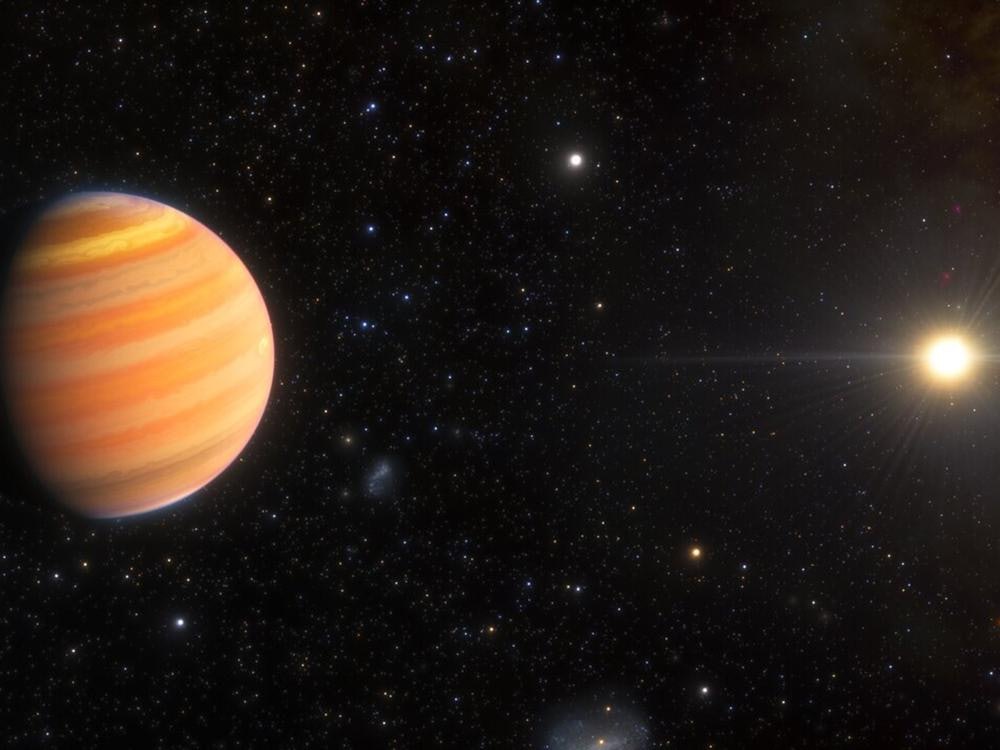
Astronomers just discovered a gas giant on its way to becoming a hot Jupiter — and it’s extremely weird.
An exoplanet on a twisted, backwards orbit may offer clues about how hot Jupiters (giant gas planets that orbit extremely close to their stars) actually form. It’s called TIC241249530b (we’ll call it TIC2 for short), and it orbits a star about 1100 light years away — backwards and in a long, stretched-thin oval. This weird orbit may be a step on the way to becoming a hot Jupiter.
Pennsylvania State University astrophysicist Arvind Gupta and his colleagues published their work in the journal Nature.

Migrating Gas Giant Caught in the Act
Astronomers discovered the giant planet TIC2 in 2020, when it crossed in front of its host star and blocked a tiny portion of the star’s light. After studying the distant star system with several other telescopes over the next few years, Gupta and his colleagues realized the planet slingshots around its star in a long, narrow oval; it swoops daringly close to its star at one end, then swings far out into the cold outer reaches of the system on the other end. It’s also orbiting its star backwards.
The gas giant is just going through a weird phase right now.
TIC2 is on its way to becoming a hot Jupiter, according to Gupta and his colleagues. “We definitely caught it in the act,” Pennsylvania State University astrophysicist Suvrath Mahadevan, a coauthor of the recent study, tells Inverse.
Although probably only about 1 percent of stars have hot Jupiters — our Sun is one of the 99 percent — they’re probably the type of exoplanet we know the most about, because they’re easiest to detect.
“How hot Jupiters form, how we ended up with planets so close to their stars, is still an unsolved mystery,” says Mahadevan.
It’s Just a Phase
According to Gupta and his colleagues’ simulations, TIC2 started its life in the outer reaches of its star system: a cosmic neighborhood comparable to the distance at which Jupiter and the other giant planets orbit our Sun. That’s where most gas giants form, and that’s where they tend to stay, unless something gives them a tremendous nudge. Our own Solar System’s giant planets have a history of wandering.
And TIC2, if Gupta and his colleagues’ simulations are right, will end up as a hot Jupiter: a giant gas planet that whizzes around its star once every ten days or less, close enough to be even hotter than the surface of Mercury.
Catching TIC2 in its so-called “warm Jupiter” phase could give astronomers some important clues about how at least some hot Jupiters form. We already know they don’t form close to their stars, because most of the volatile gas and ice grains that go into building a giant gas planet are only available far out in a star system, beyond what’s called the ice line, where temperatures are cooler. Close to stars, there’s mostly dust and bits of rock, which form solid little worlds like ours.
A Hot Jupiter is Born
Gupta and his colleagues built digital models of the star system – TIC2, its star (a slightly larger, slightly hotter version of our Sun), and a much smaller star that’s partnered with the host star in a spiraling orbital dance.
Based on those models, it looks like the smaller partner star has passed very close to TIC2 a few times over the system’s billions of years of history. Each of those close passes gave the gas giant a gravitational push or pull, shifting it onto a new orbit. And some of the orbits that show up in the computer simulations are even wilder than the current one, while some look pretty sedate by comparison. Eventually, one of those giant nudges set the planet on a backward orbit around its star.
Now, each time TIC2 swoops close to its star, the gravitational pull of the star causes powerful tides deep in the gas giant’s interior, setting immense quantities of material into sluggish motion. And when that happens, it bleeds energy, slowly settling the planet into a slower, less eccentric orbit. Right now, the planet orbits its star in an oval, stretched long and thin, every 167 days. In another hundred million or so years, the gas giant will be zipping around its star about once a week. TIC2 will be a hot Jupiter and a backwards one at that.
“We have to rely on discoveries like these”
This process is probably not how every hot Jupiter forms, although it’s apparently very similar to the life story of another giant gas planet, HD 80606b, 215 light years away. Like TIC2, this planet also orbits the larger partner in a binary star system, and it also seems to have gotten pushed and pulled into a series of weird orbits by close encounters with the neighboring star. And simulations predict a very similar fate for HD 80606; it’s also about a hundred million years away from becoming a hot Jupiter.
“It was a little bit of a surprise that we haven't found another object like HD 80606. It probably tells us that these objects are not that common,” says Mahadevan.
Gupta and his colleagues say the bizarre and eventful course of TIC2’s life is probably something unique to the largest gas giants. TIC2 is about five times more massive than Jupiter. A slightly smaller planet — one closer to Jupiter’s mass — would probably get ripped apart by tidal forces when it passed too close to its star, which is probably why astronomers have only found two very large planets in this awkward, eccentric warm Jupiter phase.
“The population of hot Jupiters probably is formed from multiple different formation channels,” says Mahadevan. “We’d like to understand all of them, but we have to rely on discoveries like these.” That’s because it’s easier for astronomers to simulate what’s going to happen to a planet like TIC2 in the future than to “roll back the clock,” as Mahadevan puts it, and reconstruct how a jot Jupiter got to where it is now.
Other options probably include interactions with other large planets in the star system, which can leave some planets falling inward while others get flung outward. And it’s not unusual for hot Jupiters to end up on weird orbits.
Meanwhile, because TIC2’s orbit brings it closest to its star just a short while before it passes between the star and our point of view here on Earth, it gives astronomers like Gupta and his colleagues a rare chance to study how a gas giant’s atmosphere responds to sudden, dramatic heating. And they plan to use that chance; Mahadevan tells Inverse the team has already applied for time on the James Webb Space Telescope.







